Strategies to Reduce High Healthcare Costs: Analysis and Methods
VerifiedAdded on 2021/04/20
|6
|1180
|68
Report
AI Summary
This report examines strategies to reduce high healthcare costs by minimizing waste in resources. It proposes several key strategies, including implementing strict guidelines, improving information systems, providing monetary benefits, and establishing updated reporting systems. The report details the ways to disseminate each strategy, such as clear communication of guidelines, advertisements, and maintaining transparency in financial transactions. It also analyzes the advantages and disadvantages of each approach, highlighting benefits like improved discipline and potential cost savings, while acknowledging drawbacks such as resistance to change and the need for careful management. The report concludes by outlining the tools necessary for the successful implementation of each strategy, such as strict penalties for non-compliance, effective advertising, and strong communication with relevant agencies.
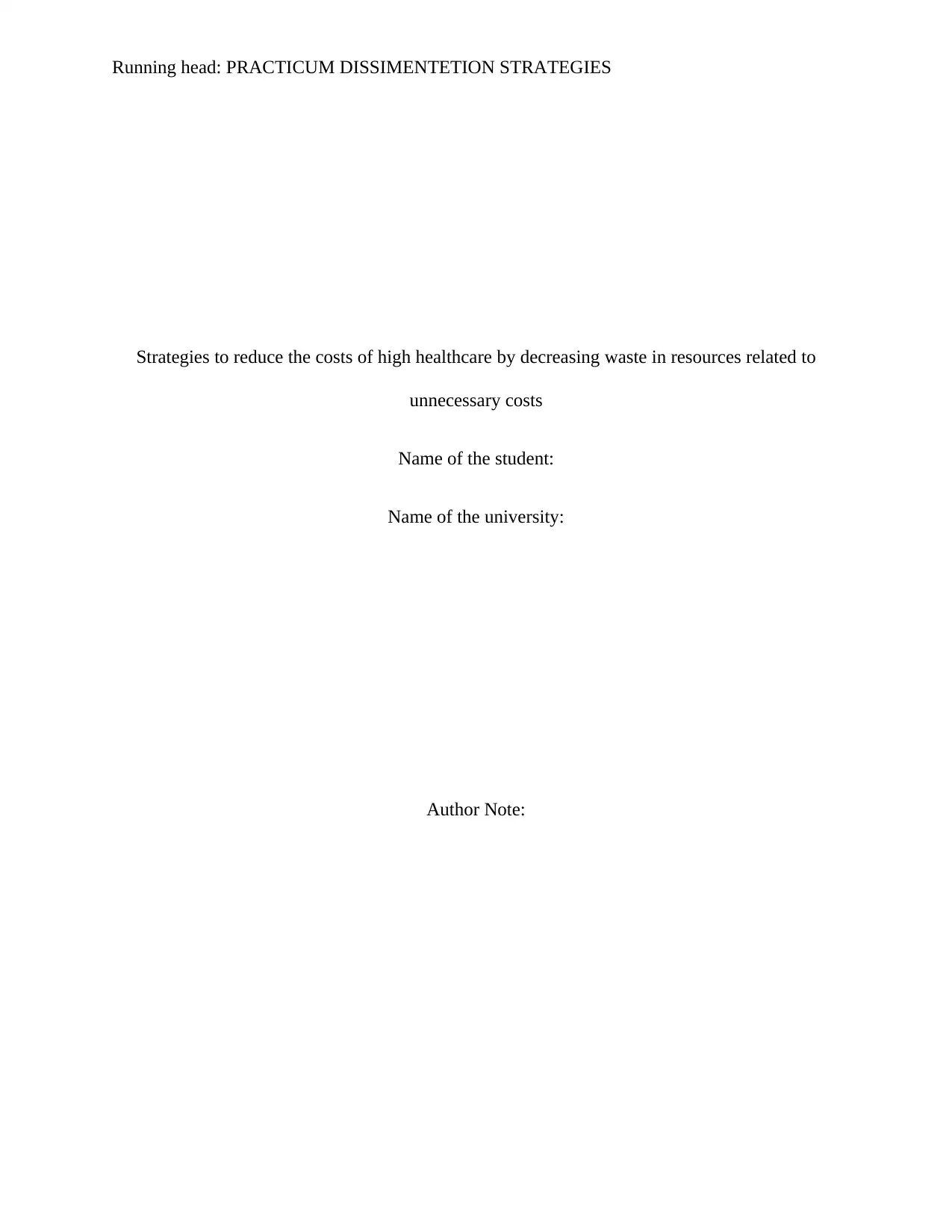
Running head: PRACTICUM DISSIMENTETION STRATEGIES
Strategies to reduce the costs of high healthcare by decreasing waste in resources related to
unnecessary costs
Name of the student:
Name of the university:
Author Note:
Strategies to reduce the costs of high healthcare by decreasing waste in resources related to
unnecessary costs
Name of the student:
Name of the university:
Author Note:
Paraphrase This Document
Need a fresh take? Get an instant paraphrase of this document with our AI Paraphraser
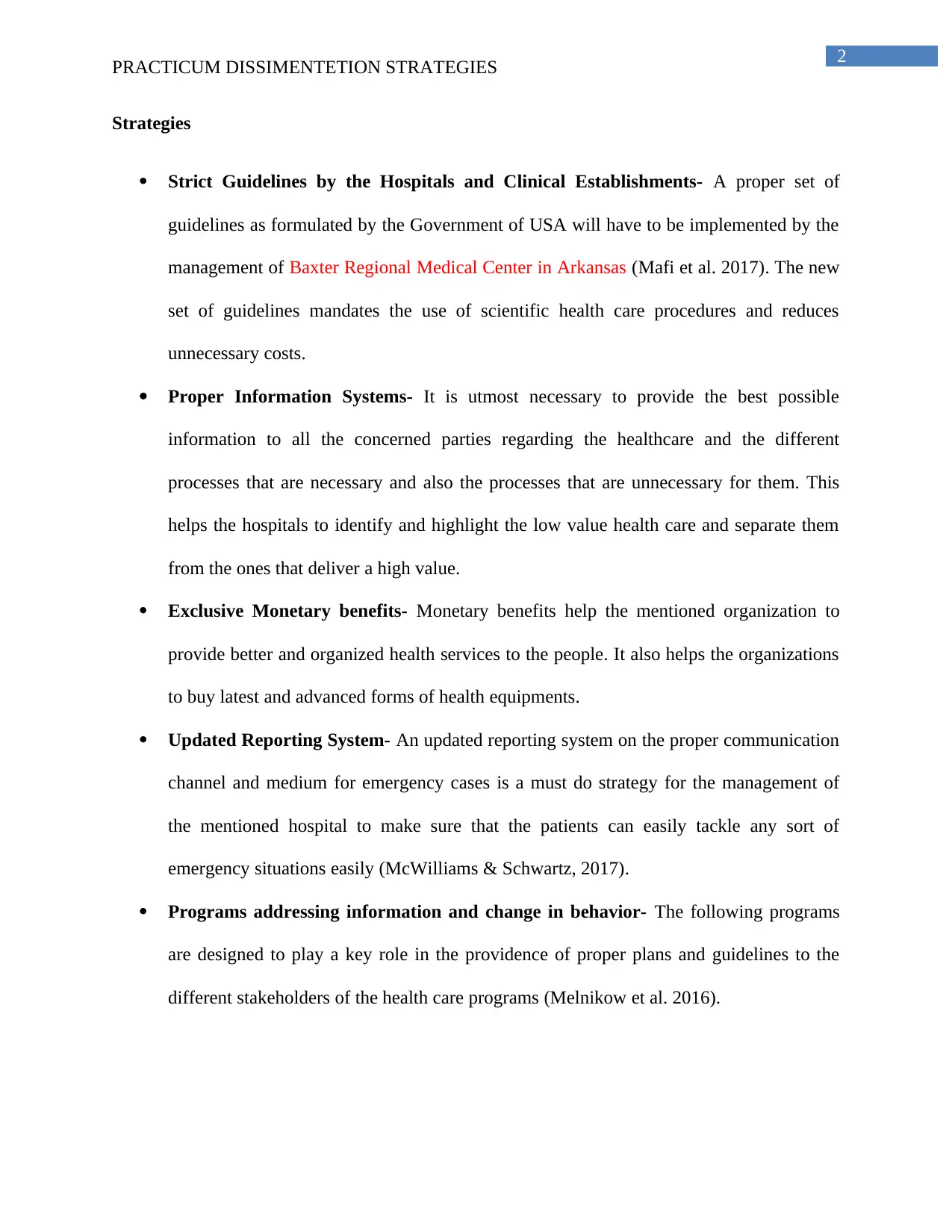
2
PRACTICUM DISSIMENTETION STRATEGIES
Strategies
Strict Guidelines by the Hospitals and Clinical Establishments- A proper set of
guidelines as formulated by the Government of USA will have to be implemented by the
management of Baxter Regional Medical Center in Arkansas (Mafi et al. 2017). The new
set of guidelines mandates the use of scientific health care procedures and reduces
unnecessary costs.
Proper Information Systems- It is utmost necessary to provide the best possible
information to all the concerned parties regarding the healthcare and the different
processes that are necessary and also the processes that are unnecessary for them. This
helps the hospitals to identify and highlight the low value health care and separate them
from the ones that deliver a high value.
Exclusive Monetary benefits- Monetary benefits help the mentioned organization to
provide better and organized health services to the people. It also helps the organizations
to buy latest and advanced forms of health equipments.
Updated Reporting System- An updated reporting system on the proper communication
channel and medium for emergency cases is a must do strategy for the management of
the mentioned hospital to make sure that the patients can easily tackle any sort of
emergency situations easily (McWilliams & Schwartz, 2017).
Programs addressing information and change in behavior- The following programs
are designed to play a key role in the providence of proper plans and guidelines to the
different stakeholders of the health care programs (Melnikow et al. 2016).
PRACTICUM DISSIMENTETION STRATEGIES
Strategies
Strict Guidelines by the Hospitals and Clinical Establishments- A proper set of
guidelines as formulated by the Government of USA will have to be implemented by the
management of Baxter Regional Medical Center in Arkansas (Mafi et al. 2017). The new
set of guidelines mandates the use of scientific health care procedures and reduces
unnecessary costs.
Proper Information Systems- It is utmost necessary to provide the best possible
information to all the concerned parties regarding the healthcare and the different
processes that are necessary and also the processes that are unnecessary for them. This
helps the hospitals to identify and highlight the low value health care and separate them
from the ones that deliver a high value.
Exclusive Monetary benefits- Monetary benefits help the mentioned organization to
provide better and organized health services to the people. It also helps the organizations
to buy latest and advanced forms of health equipments.
Updated Reporting System- An updated reporting system on the proper communication
channel and medium for emergency cases is a must do strategy for the management of
the mentioned hospital to make sure that the patients can easily tackle any sort of
emergency situations easily (McWilliams & Schwartz, 2017).
Programs addressing information and change in behavior- The following programs
are designed to play a key role in the providence of proper plans and guidelines to the
different stakeholders of the health care programs (Melnikow et al. 2016).
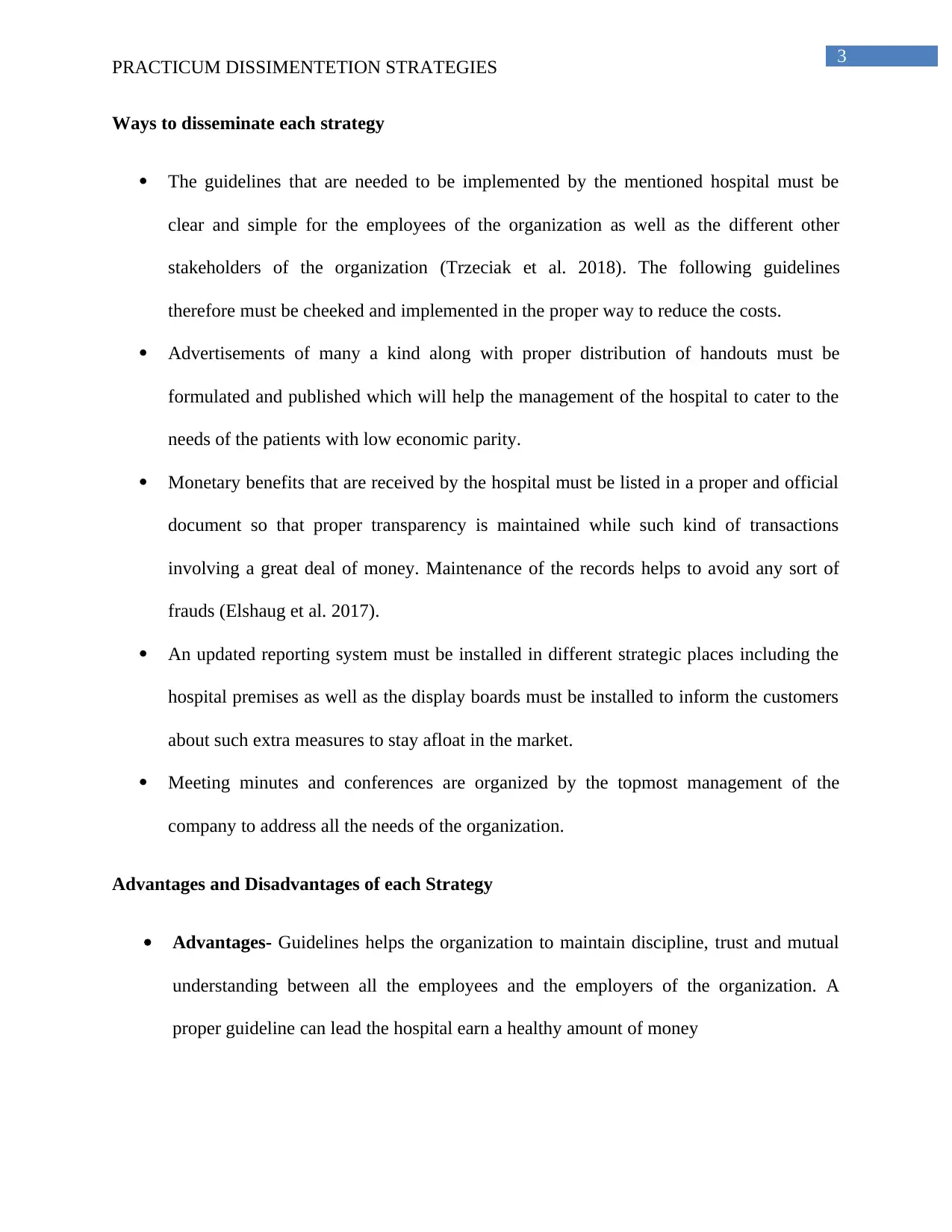
3
PRACTICUM DISSIMENTETION STRATEGIES
Ways to disseminate each strategy
The guidelines that are needed to be implemented by the mentioned hospital must be
clear and simple for the employees of the organization as well as the different other
stakeholders of the organization (Trzeciak et al. 2018). The following guidelines
therefore must be cheeked and implemented in the proper way to reduce the costs.
Advertisements of many a kind along with proper distribution of handouts must be
formulated and published which will help the management of the hospital to cater to the
needs of the patients with low economic parity.
Monetary benefits that are received by the hospital must be listed in a proper and official
document so that proper transparency is maintained while such kind of transactions
involving a great deal of money. Maintenance of the records helps to avoid any sort of
frauds (Elshaug et al. 2017).
An updated reporting system must be installed in different strategic places including the
hospital premises as well as the display boards must be installed to inform the customers
about such extra measures to stay afloat in the market.
Meeting minutes and conferences are organized by the topmost management of the
company to address all the needs of the organization.
Advantages and Disadvantages of each Strategy
Advantages- Guidelines helps the organization to maintain discipline, trust and mutual
understanding between all the employees and the employers of the organization. A
proper guideline can lead the hospital earn a healthy amount of money
PRACTICUM DISSIMENTETION STRATEGIES
Ways to disseminate each strategy
The guidelines that are needed to be implemented by the mentioned hospital must be
clear and simple for the employees of the organization as well as the different other
stakeholders of the organization (Trzeciak et al. 2018). The following guidelines
therefore must be cheeked and implemented in the proper way to reduce the costs.
Advertisements of many a kind along with proper distribution of handouts must be
formulated and published which will help the management of the hospital to cater to the
needs of the patients with low economic parity.
Monetary benefits that are received by the hospital must be listed in a proper and official
document so that proper transparency is maintained while such kind of transactions
involving a great deal of money. Maintenance of the records helps to avoid any sort of
frauds (Elshaug et al. 2017).
An updated reporting system must be installed in different strategic places including the
hospital premises as well as the display boards must be installed to inform the customers
about such extra measures to stay afloat in the market.
Meeting minutes and conferences are organized by the topmost management of the
company to address all the needs of the organization.
Advantages and Disadvantages of each Strategy
Advantages- Guidelines helps the organization to maintain discipline, trust and mutual
understanding between all the employees and the employers of the organization. A
proper guideline can lead the hospital earn a healthy amount of money
⊘ This is a preview!⊘
Do you want full access?
Subscribe today to unlock all pages.

Trusted by 1+ million students worldwide
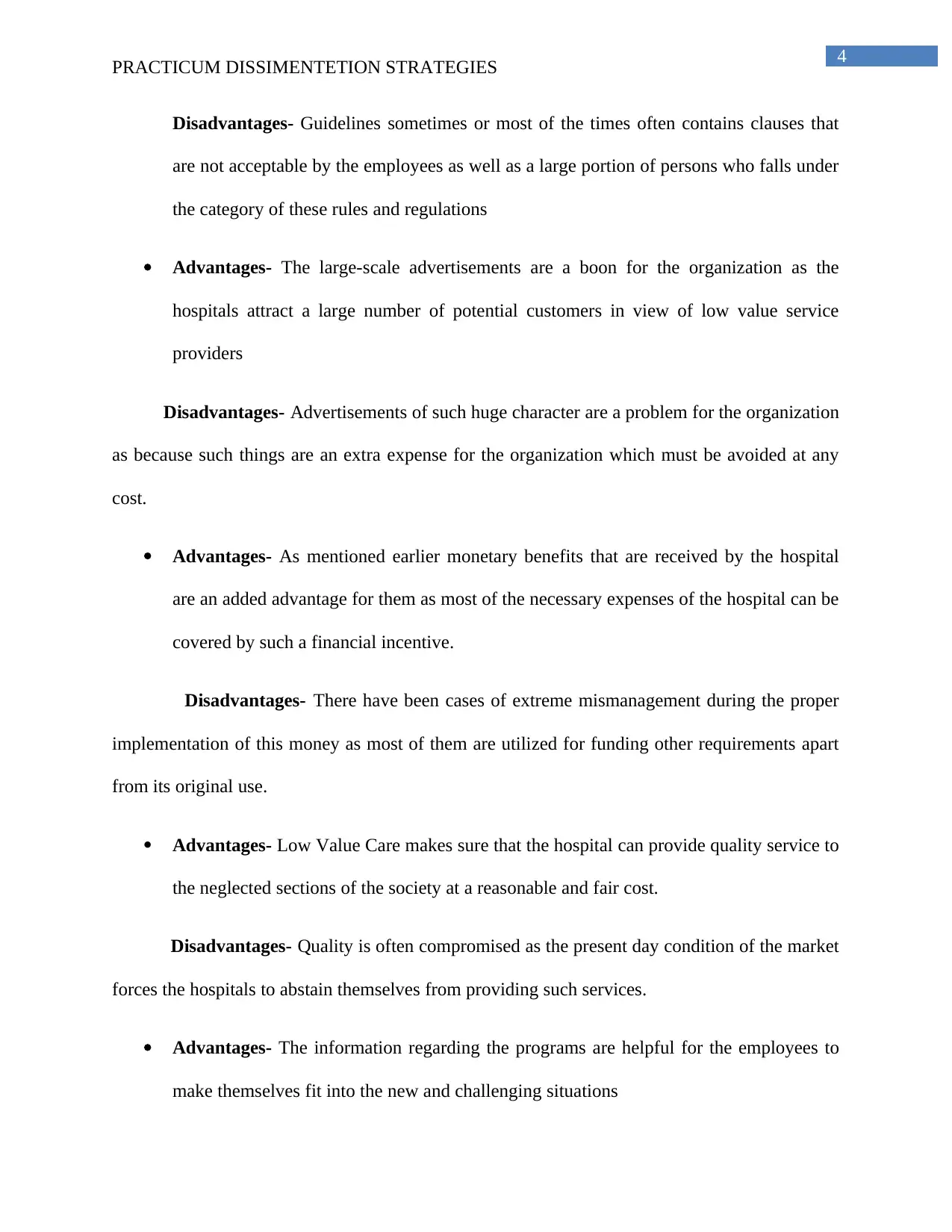
4
PRACTICUM DISSIMENTETION STRATEGIES
Disadvantages- Guidelines sometimes or most of the times often contains clauses that
are not acceptable by the employees as well as a large portion of persons who falls under
the category of these rules and regulations
Advantages- The large-scale advertisements are a boon for the organization as the
hospitals attract a large number of potential customers in view of low value service
providers
Disadvantages- Advertisements of such huge character are a problem for the organization
as because such things are an extra expense for the organization which must be avoided at any
cost.
Advantages- As mentioned earlier monetary benefits that are received by the hospital
are an added advantage for them as most of the necessary expenses of the hospital can be
covered by such a financial incentive.
Disadvantages- There have been cases of extreme mismanagement during the proper
implementation of this money as most of them are utilized for funding other requirements apart
from its original use.
Advantages- Low Value Care makes sure that the hospital can provide quality service to
the neglected sections of the society at a reasonable and fair cost.
Disadvantages- Quality is often compromised as the present day condition of the market
forces the hospitals to abstain themselves from providing such services.
Advantages- The information regarding the programs are helpful for the employees to
make themselves fit into the new and challenging situations
PRACTICUM DISSIMENTETION STRATEGIES
Disadvantages- Guidelines sometimes or most of the times often contains clauses that
are not acceptable by the employees as well as a large portion of persons who falls under
the category of these rules and regulations
Advantages- The large-scale advertisements are a boon for the organization as the
hospitals attract a large number of potential customers in view of low value service
providers
Disadvantages- Advertisements of such huge character are a problem for the organization
as because such things are an extra expense for the organization which must be avoided at any
cost.
Advantages- As mentioned earlier monetary benefits that are received by the hospital
are an added advantage for them as most of the necessary expenses of the hospital can be
covered by such a financial incentive.
Disadvantages- There have been cases of extreme mismanagement during the proper
implementation of this money as most of them are utilized for funding other requirements apart
from its original use.
Advantages- Low Value Care makes sure that the hospital can provide quality service to
the neglected sections of the society at a reasonable and fair cost.
Disadvantages- Quality is often compromised as the present day condition of the market
forces the hospitals to abstain themselves from providing such services.
Advantages- The information regarding the programs are helpful for the employees to
make themselves fit into the new and challenging situations
Paraphrase This Document
Need a fresh take? Get an instant paraphrase of this document with our AI Paraphraser
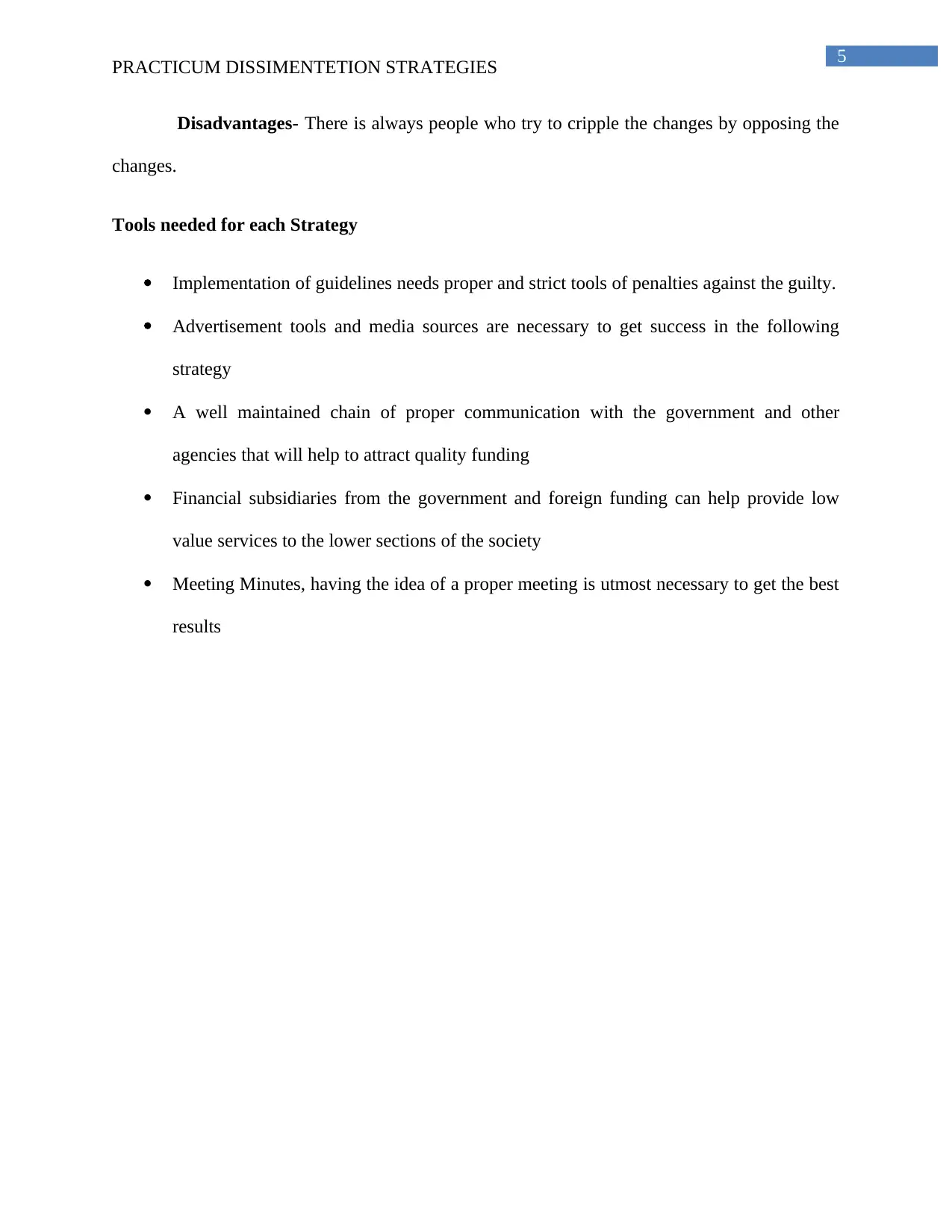
5
PRACTICUM DISSIMENTETION STRATEGIES
Disadvantages- There is always people who try to cripple the changes by opposing the
changes.
Tools needed for each Strategy
Implementation of guidelines needs proper and strict tools of penalties against the guilty.
Advertisement tools and media sources are necessary to get success in the following
strategy
A well maintained chain of proper communication with the government and other
agencies that will help to attract quality funding
Financial subsidiaries from the government and foreign funding can help provide low
value services to the lower sections of the society
Meeting Minutes, having the idea of a proper meeting is utmost necessary to get the best
results
PRACTICUM DISSIMENTETION STRATEGIES
Disadvantages- There is always people who try to cripple the changes by opposing the
changes.
Tools needed for each Strategy
Implementation of guidelines needs proper and strict tools of penalties against the guilty.
Advertisement tools and media sources are necessary to get success in the following
strategy
A well maintained chain of proper communication with the government and other
agencies that will help to attract quality funding
Financial subsidiaries from the government and foreign funding can help provide low
value services to the lower sections of the society
Meeting Minutes, having the idea of a proper meeting is utmost necessary to get the best
results
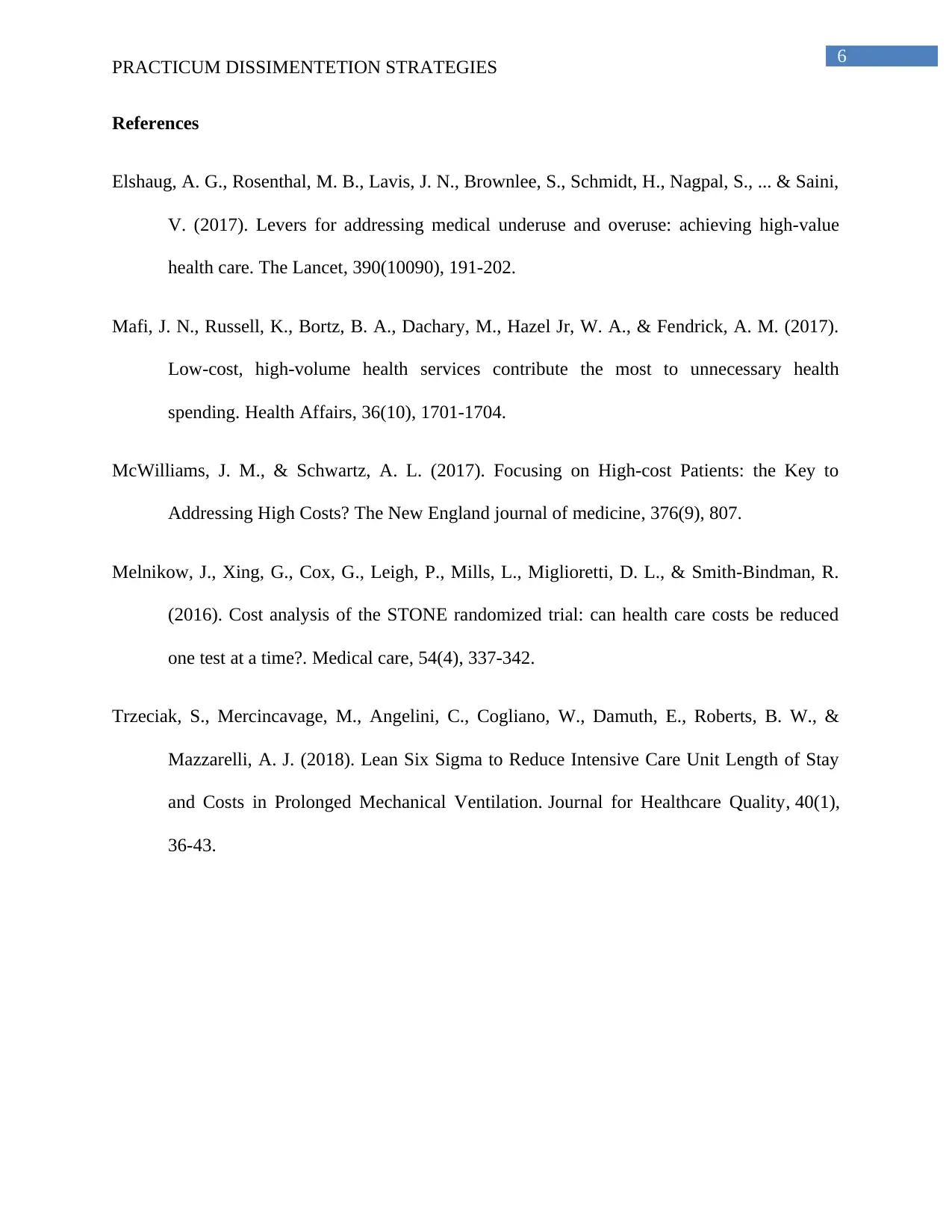
6
PRACTICUM DISSIMENTETION STRATEGIES
References
Elshaug, A. G., Rosenthal, M. B., Lavis, J. N., Brownlee, S., Schmidt, H., Nagpal, S., ... & Saini,
V. (2017). Levers for addressing medical underuse and overuse: achieving high-value
health care. The Lancet, 390(10090), 191-202.
Mafi, J. N., Russell, K., Bortz, B. A., Dachary, M., Hazel Jr, W. A., & Fendrick, A. M. (2017).
Low-cost, high-volume health services contribute the most to unnecessary health
spending. Health Affairs, 36(10), 1701-1704.
McWilliams, J. M., & Schwartz, A. L. (2017). Focusing on High-cost Patients: the Key to
Addressing High Costs? The New England journal of medicine, 376(9), 807.
Melnikow, J., Xing, G., Cox, G., Leigh, P., Mills, L., Miglioretti, D. L., & Smith-Bindman, R.
(2016). Cost analysis of the STONE randomized trial: can health care costs be reduced
one test at a time?. Medical care, 54(4), 337-342.
Trzeciak, S., Mercincavage, M., Angelini, C., Cogliano, W., Damuth, E., Roberts, B. W., &
Mazzarelli, A. J. (2018). Lean Six Sigma to Reduce Intensive Care Unit Length of Stay
and Costs in Prolonged Mechanical Ventilation. Journal for Healthcare Quality, 40(1),
36-43.
PRACTICUM DISSIMENTETION STRATEGIES
References
Elshaug, A. G., Rosenthal, M. B., Lavis, J. N., Brownlee, S., Schmidt, H., Nagpal, S., ... & Saini,
V. (2017). Levers for addressing medical underuse and overuse: achieving high-value
health care. The Lancet, 390(10090), 191-202.
Mafi, J. N., Russell, K., Bortz, B. A., Dachary, M., Hazel Jr, W. A., & Fendrick, A. M. (2017).
Low-cost, high-volume health services contribute the most to unnecessary health
spending. Health Affairs, 36(10), 1701-1704.
McWilliams, J. M., & Schwartz, A. L. (2017). Focusing on High-cost Patients: the Key to
Addressing High Costs? The New England journal of medicine, 376(9), 807.
Melnikow, J., Xing, G., Cox, G., Leigh, P., Mills, L., Miglioretti, D. L., & Smith-Bindman, R.
(2016). Cost analysis of the STONE randomized trial: can health care costs be reduced
one test at a time?. Medical care, 54(4), 337-342.
Trzeciak, S., Mercincavage, M., Angelini, C., Cogliano, W., Damuth, E., Roberts, B. W., &
Mazzarelli, A. J. (2018). Lean Six Sigma to Reduce Intensive Care Unit Length of Stay
and Costs in Prolonged Mechanical Ventilation. Journal for Healthcare Quality, 40(1),
36-43.
⊘ This is a preview!⊘
Do you want full access?
Subscribe today to unlock all pages.

Trusted by 1+ million students worldwide
1 out of 6
Related Documents
Your All-in-One AI-Powered Toolkit for Academic Success.
+13062052269
info@desklib.com
Available 24*7 on WhatsApp / Email
![[object Object]](/_next/static/media/star-bottom.7253800d.svg)
Unlock your academic potential
Copyright © 2020–2025 A2Z Services. All Rights Reserved. Developed and managed by ZUCOL.





